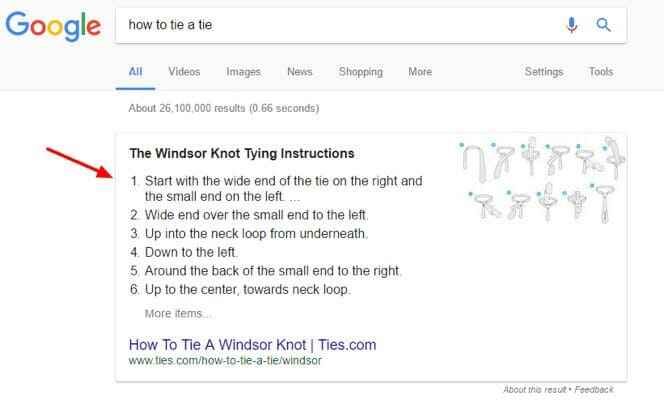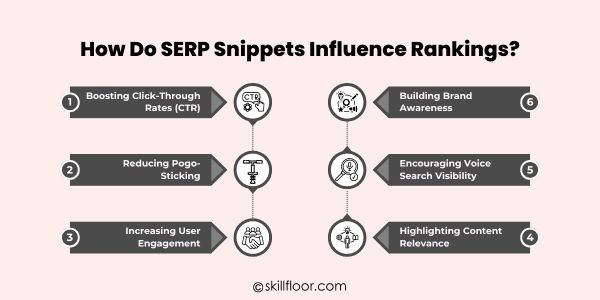The Role of SERP Snippets in Rankings
How SERP snippets influence search engine rankings. Learn about different types of snippets and their impact on visibility, click-through rates, and SEO performance.

Imagine that you have never cooked a cake before, but you have a strong desire for a delectable handmade cake. Enter "What's the best way to bake a cake?" into Google. You don't have to click on any links to get detailed instructions; a box appears at the top of the page instantly. That's what a SERP snippet, a tool made to speed up and simplify your search, is all about.
As someone who has baked many cakes, I understand how helpful SERP snippets can be for finding reliable and quick answers. Google's algorithm highlights clear and accurate information, often breaking down instructions into easy-to-follow steps. Whether you're a beginner baker or an experienced cook, these snippets serve as a virtual guide.
SERP snippets frequently include advice from reputable websites with a solid reputation for accuracy and depth, such as Food Network or AllRecipes. Google guarantees that snippets originate from trustworthy sources that employ comprehensible language, include citations and offer readers current, relevant content.
What Are SERP Snippets?
SERP snippets are concise pieces of content shown on search engine results pages (SERPs) that deliver quick answers to user questions. These snippets are time-saving tools, providing information directly on the search page, which is particularly useful for users seeking specific solutions or advice.
Being highlighted in SERP snippets may increase a creator's or business's exposure and reputation. By optimizing their content for snippets, for instance, websites that provide digital marketing courses may attract a lot of interest and assist visitors in finding pertinent, organized, and succinct information in a short amount of time. This boosts clicks and user trust.
Types of SERP Snippets
-
Featured Snippets: These assist consumers get what they need fast by providing straightforward answers at the top of search results, frequently in the form of lists, bullet points, or brief paragraphs.

-
Rich Snippets: These provide readers with more context about the material, particularly for reviews or items, by including extra information like star ratings, pricing, or photos.

-
Knowledge Panels: These snippets, which are located on the side of the search page, provide concise, verifiable information on individuals, groups, or subjects.
-
Video Snippets: These highlight videos, which are frequently taken from websites like YouTube and are relevant to the search query, provide a visually appealing and captivating method of responding to inquiries in digital marketing and other domains.
-
Image Pack Snippets: These make searches visually instructive by displaying a carousel of similar photos that frequently occur for design, fashion, or travel-related keywords.
-
People Also Ask: These expanding questions encourage further investigation of the subject while providing users with relevant topics and prompt replies.
Why SERP Snippets are Important in SEO
-
Boosts Visibility: Despite not being listed first in search results, SERP snippets draw visitors' attention by displaying material prominently, increasing a website's visibility.
-
Drives Traffic: Featured snippets frequently drive more clicks and substantial traffic to your website by offering pertinent and speedy responses right in search results.
-
Builds Authority: Your site will become an authoritative source if it is highlighted in snippets, which will improve your entire SEO strategy by demonstrating your experience and dependability.
-
Improves User Experience: Providing succinct, organized information, snippets improve user pleasure and support Google's mission to provide relevant and useful content.
-
Supports Search Intent: Snippets make sure your content connects with consumers' needs by answering particular user questions, which is an essential ability for any SEO specialist to have.
-
Indirect Ranking Boost: Although snippets have no direct effect on results, they increase user engagement and click-through rates (CTR), which tell search engines that your content is valuable.
How Do SERP Snippets Influence Rankings?
The problem is that snippets by themselves don't raise your ranks. They can, however, have a number of indirect effects on rankings. Let's dissect it:
1. Boosting Click-Through Rates (CTR)
Your content is more striking when it is presented as a sample. People are more inclined to click on your link since they believe your website to be reliable and pertinent.
2. Reducing Pogo-Sticking
Pogo-sticking is the practice of people clicking on a result, realizing it isn't useful, and then returning to the search results. By providing consumers with just what they need up front, snippets assist to lessen this.
3. Increasing User Engagement
Because people that click through to your content are truly interested in it, using snippets frequently results in increased time spent on your website.

4. Highlighting Content Relevance
Selecting your website for a snippet tells search engines that your content is exactly what users are looking for, which consequently increases your chances of appearing for related searches.
5. Encouraging Voice Search Visibility
Since voice search responses are frequently derived from SERP snippets, your content will be more visible in the expanding voice search trend, which may eventually result in higher results.
6. Building Brand Awareness
The exposure and authority of your brand are increased when consumers see your website mentioned in snippets on a regular basis. This awareness and trust-building enhances your SEO approach.
How to Optimize for SERP Snippets
After learning how snippets function, let's discuss how to make your content snippet-friendly.
1. Create Content That Answers Questions
The majority of snippets come from information that directly responds to frequently asked questions. Utilize resources like Google's "People Also Ask" section to discover the questions others have regarding your subject.
2. Use Clear and Concise Formatting
Easy-to-read and scan information is highly valued by Google. To prepare your content for snippets, follow these steps:
-
Use bullet points or numbered lists: Provide data in organized lists so that consumers may easily understand important aspects.
-
Include headings and subheadings: Make sure your information is arranged with distinct headers to facilitate easy navigation for both readers and search engines.
-
Write short, clear paragraphs: Divide difficult concepts into manageable, user-friendly chunks that are brief and interesting.
3. Add Schema Markup
You may use a form of coding called schema markup on your website to improve search engine comprehension of your content. For instance:
-
Use recipe schema for cooking instructions: Incorporate structured data into search results to emphasize ingredients, cooking times, and preparation procedures.
-
Add product schema for e-commerce pages: To make your listings more eye-catching and educational, highlight product data like price, availability, and ratings.
4. Match Search Intent
Ensure that your content is in line with user search terms. Give them detailed instructions if they ask "how." Give them a concise and straightforward answer if they are looking for definitions.
5. Optimize for Keywords Naturally
Make an effort to include keywords organically in your writing. To increase your chances of appearing in snippets, include keywords in titles, subheadings, and replies rather than jamming them in.
6. Keep Content Fresh and Updated
Make sure your content is correct and up to date by updating it frequently. You can get an advantage by examining and updating material because Google loves to display current information in snippets.
Measuring the Impact of SERP Snippets
1. Track Click-Through Rates (CTR)
Track how the appearance of your snippet affects CTR to see if your material is unique and gets more clicks from search results.
2. Analyze Organic Traffic
Find out from your statistics whether snippets are gradually increasing the number of organic visitors to your website.
3. Monitor Keyword Performance
Monitoring the performance of your target keywords is important, particularly when it comes to your SERP Ranking and snippet exposure.
4. Evaluate User Engagement
In order to ascertain whether snippet-driven visitors are finding your material helpful and remaining on your website longer, evaluate indicators such as bounce rates and page length.
5. Measure Conversion Rates
To determine how traffic from snippets affects your objectives, examine if it results in conversions like product purchases, sign-ups, or downloads.
6. Study Competitor Snippets
Examine how rivals use snippets for your desired keywords, and devise tactics to improve your own chances of showing up top.
Common Challenges in Targeting Snippets
1. Zero-Click Searches
Despite being featured, people may find that the snippet provides all the information they want without ever visiting your website, which lowers traffic.
2. Algorithm Updates
Google often modifies its selection process for SERP Snippets. It is essential to be informed about these developments in order to stay visible.
3. Increased Competition
Because so many websites are vying for snippet places, having content that is high-quality, easy to use, and optimized for search intent is essential to sticking out.
4. Content Length Balance
It might be challenging to strike the correct balance between succinct responses and in-depth explanations since snippets emphasize succinct, straightforward answers while maintaining important material.
5. Query Variations
Targeting snippets for numerous worded questions is difficult as consumers frequently search in different ways, necessitating that you modify your material to adequately address these variants.
6. Localization Issues
Snippets may prioritize localized content, which can reduce exposure for audiences throughout the world unless your content is relevant to user demands and regional search preferences.
Future Trends in SERP Snippets
1. Increased Personalization
Artificial Intelligence will probably be used by search engines to customize SERP Snippets according to user location, search history, and preferences for a more individualized experience.
2. Voice Search Integration
As voice assistants become more popular, snippets will be tailored to provide succinct, conversational responses that are appropriate for natural language processing and voice inquiries.
3. Enhanced Visual Content
Snippets will likely have more interactive components, such as pictures, videos, and possibly augmented reality, which will enhance the interest and educational value of search results.
4. Real-Time Updates
Snippets may begin to show consumers real-time data, such as stock updates, weather updates, or live scores, giving them access to dynamic information instantly.
5. Expanded Snippet Types
New snippet types, such as those catered to hyper-niche subjects or industry-specific inquiries, will appear to meet changing search demands.
6.AI-Driven Snippet Selection
Selecting the most pertinent snippets will be more heavily influenced by advanced AI, which will prioritize user delight, intent matching, and content quality.
SERP Snippets are revolutionizing modern search by facilitating consumers' access to trustworthy and timely information right on search pages. These tidbits provide firms a chance to become more visible and authoritative. You may maximize your chances of getting featured by concentrating on creating material that is easy to use, employing keywords naturally, and keeping up with current trends. SERP snippets are becoming an essential part of search tactics, making them more than simply a convenience; they give businesses a competitive advantage. By embracing their potential, you may improve your SEO strategy and leave a lasting impression on consumers who are looking for pertinent, meaningful solutions in the current digital environment.




























































